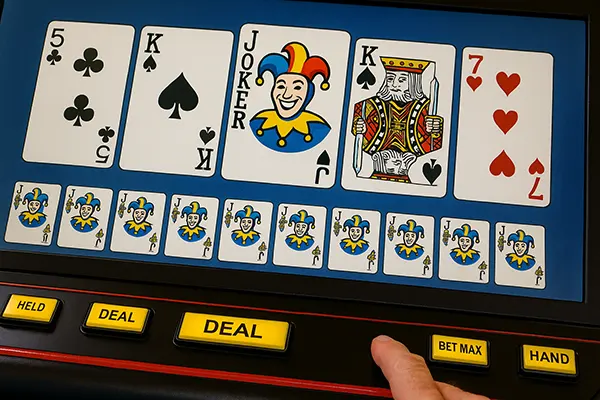Joker’s Wild Multi-Hand: The Fusion of Wild Cards and Multi-Hand Video Poker
The combination of Joker’s Wild mechanics and the multi-hand mode has transformed the traditional approach to video poker. This format allows players to manage several hands at once while using jokers as wild cards to complete winning combinations. The result is a dynamic balance between mathematical precision and strategic flexibility that appeals to advanced poker enthusiasts.
How Multi-Hand Play Changes the Strategy
When multiple hands are active, every decision has an amplified effect. A single draw can influence several results simultaneously, which means that the optimal strategy differs from the single-hand version. Players must assess not only the best way to hold or discard cards but also how potential outcomes across all hands affect the expected return.
In a standard Joker’s Wild game, the presence of the joker already increases volatility. In the multi-hand version, that volatility multiplies, as each additional hand increases both potential winnings and variance. To stay consistent, many players rely on simulation tools or practice software that models expected values across hundreds of rounds.
Another key strategic difference lies in risk management. Multi-hand play encourages diversification across multiple outcomes rather than focusing on one perfect hand. This structure rewards analytical thinking, as it requires the player to anticipate probability spreads and adapt in real time.
Impact of Wild Cards on Decision-Making
The joker acts as a universal substitute, but its real power lies in the flexibility it introduces to probability. With one or more jokers available, drawing combinations like five-of-a-kind becomes possible, reshaping paytable dynamics. In multi-hand mode, this influence grows exponentially, making each decision point more significant.
Wild cards increase the effective hit frequency, but they can also alter payout distributions. Because hands complete more easily, high-value outcomes may appear less frequently. Skilled players track statistical data to understand how wilds influence expected returns per hand and overall session variance.
Mathematically, a joker in a 53-card deck shifts the edge by roughly 0.8–1.1% compared to standard video poker. When multiplied across 10 or more simultaneous hands, that adjustment creates measurable differences in payout cycles, often requiring recalibrated strategies and tighter bankroll discipline.
Understanding the Multi-Joker’s Wild Paytables
Paytables are the foundation of any video poker variant, and the multi-hand Joker’s Wild format introduces unique patterns. Depending on the casino software provider, players can encounter several versions — 6/5, 7/5, or full-pay 8/5 structures. Each number pair represents the return ratios for full house and flush hands respectively, directly influencing the theoretical return-to-player (RTP).
In a full-pay multi-hand Joker’s Wild, the RTP can reach up to 100.65% with perfect play, making it one of the few positive-expectation formats in 2025. However, most online versions offer lower tables, ranging from 98.1% to 99.9%, balancing entertainment value with statistical realism.
Players should always verify the exact paytable before playing. Differences as small as one credit per payout category can have a long-term impact, particularly across multiple hands. Transparent operators display full payout tables and probabilities, allowing analytical players to compare and select the most favourable version.
Mathematical Models and Simulations
Modern analytical tools can simulate millions of hands to model long-term expectations for Joker’s Wild Multi-Hand play. These simulations show that variance per hand can double compared to single-hand poker, while session-length volatility can increase by a factor of 1.5–2.0 depending on the number of active hands.
For example, a simulation of 10-hand Joker’s Wild using an 8/5 table demonstrates that players encounter a major payout every 1,200 hands on average, with smaller wins occurring far more frequently. These findings confirm the balance between risk and reward that defines this poker variation.
Such mathematical insights allow professional players to refine their approach. By analysing hit frequencies, expected values, and bankroll fluctuations, they can create data-driven strategies optimised for both entertainment and return stability.

Bankroll Management and Practical Advice
Effective bankroll management is essential for long-term success in multi-hand video poker. Because multiple hands are played simultaneously, total bet size increases proportionally. A session of 10 hands at 5 credits per hand means 50 credits per round — a much higher exposure compared to single-hand play.
Experts recommend setting aside at least 300–500 bets per session to mitigate variance. This range ensures enough buffer to survive downswings without reducing play quality. Advanced players often segment their bankrolls into separate categories — testing, grinding, and bonus play — each with distinct limits.
It is also crucial to use analytics to track average returns and deviations. Responsible gambling tools now allow players to set spending caps, automatically pause sessions, and review performance data — aligning with the industry’s growing focus on transparency and player welfare in 2025.
Comparing Multi-Hand Joker’s Wild to Other Formats
Compared with regular Joker’s Wild, the multi-hand version demands faster decisions and greater focus. Each round delivers more data points, and therefore more opportunities to refine one’s play through statistical observation. This appeals to mathematically oriented players who prefer calculated, evidence-based decision-making.
When compared with non-wild multi-hand poker, the Joker’s Wild variant offers higher volatility and a more diverse payout profile. Wild cards can transform near-misses into successful hands, altering the emotional rhythm of the game and keeping engagement high without sacrificing analytical depth.
Ultimately, the combination of wild cards and multi-hand functionality represents a bridge between entertainment and skill. While chance remains a core element, strategic understanding, probability modelling, and disciplined bankroll management define consistent success in this evolving poker format.
